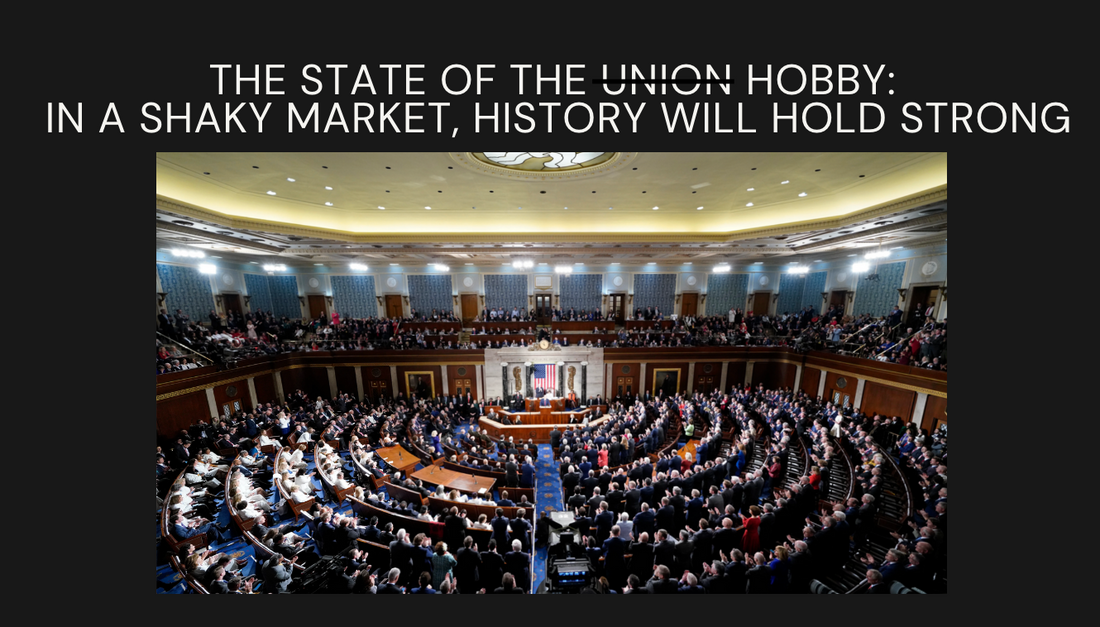
State of the Historical Hobby: In a Shaky Market, History will Hold Strong
Share
As the stock market takes a downward turn, investors and collectors alike are looking for safe havens—places where value isn’t dictated by headlines, inflation reports, or social media trends. It is likely that this is going to be a scary week and in times like these, it’s worth pausing to consider a timeless asset class that has quietly stood the test of economic upheaval, global crises, and generational change:
Collecting history.
Personally, I was drawn more seriously into this world during the COVID-19 pandemic, when volatility shook nearly every asset class—from stocks and cryptocurrencies to modern collectibles. In contrast, the historical memorabilia market remained remarkably stable—more than that, it thrived, even during the scarier times! During the “Covid Collectibles Boom,” we saw a healthy 10–20% increase in value across many categories of historical collectibles—growth that was organic and supported by genuine collector demand. Unlike the unsustainable, hype-driven spikes in value seen in other collectible asset classes, historical memorabilia appreciated in a steady, rational manner.
But I believe this time feels different. Unlike the pandemic-era surge, we’re unlikely to see the same broad increase in values across collectibles. There isn’t an influx of stimulus capital being injected into the economy, and people aren’t confined to their homes with time and money to explore new collecting hobbies. The world is open, and recently we saw discretionary spending shift toward experiences—travel, dining, events.
Today, that trend is showing signs of strain. We’re seeing a considerable downturn in key airline and travel stocks, with multiple companies lowering their future earnings estimates. This suggests that the experience economy may be softening—and as consumer confidence wavers, collectors are seeking out assets, and we believe today more than ever, collectibles with historical significance and lasting value can lead the way.
So why is this market so steady, even in uncertain times? Let’s break it down.
Why we view Historical Memorabilia as a Safe Asset
1. True Scarcity, Not Manufactured Limited Editions
Unlike modern collectibles—where scarcity is often engineered by slapping a serial number on mass-produced items—historical autographs and documents are actually rare. Abraham Lincoln isn’t signing anything new. George Washington isn't writing another battlefield dispatch. There is no factory producing more of these pieces. What exists today is all that will ever exist.
2. Permanent Loss Is Real
This isn’t a stable pool of items—it’s a shrinking one. Fires, floods, hurricanes, and improper storage can destroy even well-preserved historical items. Every year, a portion of our shared material heritage is lost forever to natural disasters or simple neglect.
3. Institutional Lock-Up: Gone for Good
And the items that do survive? More and more are being acquired by museums, libraries, and academic archives. When an institution adds a Thomas Jefferson letter or a World War II general’s battlefield journal to its collection, it disappears from the private market—often permanently.
These institutions aren’t resellers; they’re preservationists. Their mission is to protect and study these items, not circulate them. Each acquisition by a public archive or private institution represents one more item removed from the collector’s reach, often indefinitely.
This ongoing absorption into locked collections means fewer and fewer high-quality pieces are available to collectors each year. The result? A fixed—and slowly shrinking—supply.
4. Modern Trends Are Reducing the Available Supply — and Introducing New Collectors
Another trend impacting the historical memorabilia market is the growing use of “cut signatures” in modern collectibles—especially trading cards and display pieces. In recent years, companies have been acquiring authentic signatures to embed them into cards or decorative items. Every time a Lincoln signature is cut and used in this way, that’s one less relic available to traditional collectors.
Yes, it reduces supply—but it also opens the door to something exciting: exposure of our industry to an entirely new generation of collectors.
That’s actually how I got started. Like many, I was first introduced to historical signatures through modern formats. It sparked a deeper curiosity, and before long I found myself wanting more than a card—I wanted context, provenance, and a story.
That journey led me to where I am today. Heck, thanks to modern trading cards, I am sitting on my couch on a Sunday, while watching the Yankee game and writing this “State of the Historical Hobby” blog post.
So while this trend does limit the number of intact documents in circulation, it also plays an important role in growing a new and young collector base. For those intrigued by a cut signature of Lincoln or Washington, it’s often just the beginning. Many soon discover the richness of this hobby and transition toward full historical documents, letters, and relics—bringing fresh energy and appreciation into the space.
5. A Thoughtful, High-Net-Worth Collector Base
Collectors of historical memorabilia tend to be informed, discerning, and often high-net-worth individuals. They’re not following fads—they’re curating legacies. Whether motivated by passion for history, investment strategy, or family heritage, they’re typically long-term holders who value authenticity and cultural significance. This stable collector profile helps buffer the market from extreme swings.
How the Market Is Performing Right Now
Given the recent stock market slide, we’re closely monitoring how the historical autograph world is responding—and the results are encouraging.
RR Auction, the first major auction to close post-downturn, ends this Wednesday. Early indicators show consistent bidder activity with no sign of pullback.
University Archives, only four days into their current sale, is already seeing above-average bidding activity across a wide range of lots. That’s an incredibly positive signal.
Heritage Auctions, which continues to hold a strong presence in the historical space, is maintaining solid engagement from both seasoned collectors and new entrants.
Confidence in the Future
This market isn’t powered by hype. It’s powered by authenticity, scarcity, and reverence. While other asset classes may rise and fall on a whim, historical memorabilia maintains its dignity—and its demand. These aren’t just collectibles. They’re cultural artifacts. They’re investments with a soul.
We aren’t just dealing in ink on paper—we’re preserving stories, legacies, and defining moments in human history. Each item has a fixed place in time, a fixed supply, and an emotional and intellectual value that transcends trends. There is no app that can replace holding a letter signed by a Founding Father. No digital file can compare to standing in front of a document that helped shape the world. In uncertain times, collectors turn to what endures. And history always endures. That’s why we believe so strongly in the resilience of this market.
The collectors entering this space are thoughtful, driven by passion and purpose. The demand isn’t fueled by speculation—it’s built on respect for the past and a desire to preserve it. And as younger generations are introduced to this world—through cut signature cards, classroom visits to museums, or scrolling through our carefully curated collections—they’re discovering that this hobby isn’t just meaningful… it’s timeless.
The world may change. Markets may shift. But the value of authenticity, of rarity, and of connection to our shared past remains. The historical memorabilia market has weathered centuries—and it’s only becoming more significant with time.
We'll close with this question...
Don’t you wish you could go back to pre-COVID 2020 and buy that Lincoln signed appointment for $5,000?
The last closed sale for a nice example sold at University Archives' February auction—went for $23,750 all in.

1 comment
This is thoughtful insight in the historical collectibles market. The one problem I see is not in items retaining value and attractiveness to collectors old and new to the hobby, but in discretionary funds being available to the less well-healed collector. With stocks down and investments showing decline, money will be seen as a living necessity. For longtime hobbyists, it’s in our blood and we’ll continue to explore history in all its facets.